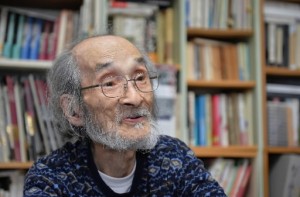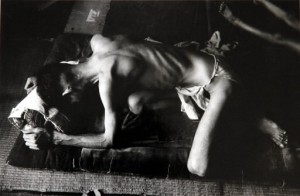More than 200,000 negatives of photojournalist, questioning postwar period, to be digitized
Jul. 16, 2015
by Ryutaro Inoue, Staff Writer
Kikujiro Fukushima, 94, an anti-establishment photojournalist in Yanai City, Yamaguchi Prefecture who relentlessly captured images of postwar Japan in his work, will digitize his negatives with the support of Kyodo News Images, based in Tokyo. The subjects of his photos are A-bomb survivors in Hiroshima, the conflict over the Japan-U.S. Security Treaty, Japan’s Self-Defense Forces, and the campaign against the construction of the Kaminoseki nuclear power plant. The negatives of all his photographs, which have produced a strong response from the public, are held in his apartment. He hopes that “my photos, which question Japan’s stance on these issues, will survive beyond the end of my life.”
Mr. Fukushima has consistently remained loyal to his beliefs in opposing war and Japan’s political and social systems. His anti-establishment views began as a result of his experiences in World War II. He was drafted by the Imperial Japanese Army and, after undertaking training in the city of Hiroshima, was dispatched to Nichinan Seashore, in Miyazaki Prefecture, to serve as a “suicide bomber” in the expected mainland battle. This was just six days before the atomic bomb was dropped on Hiroshima and, because Japan was defeated, Mr. Fukushima did not fight in the war.
After the war he was demobilized and returned to his hometown, the city of Kudamatsu, Yamaguchi Prefecture. The next year, 1946, he read a newspaper article which said that grass was growing around the ruined building which came to be known as the Atomic Bomb Dome. He then went to Hiroshima and began taking photos. For 10 years, he documented, in graphic detail, an A-bomb survivor who suffered from the aftereffects of the atomic bomb, along with the man’s family. His photo collection, Pikadon: Aru Genbaku Hisaisha no Kiroku (Record of an A-bomb Survivor), received a special award from the Japan Photo Critics Association.
Mr. Fukushima focused his camera on student movements, the Sanrizuka conflict (also known as the Narita conflict) over the construction of Narita Airport, and the movement of the people of Iwaishima Island against the construction of a nuclear power plant at nearby Kaminoseki town in Yamaguchi Prefecture. Over the years, he persisted in his efforts to reveal the contradictions of the nation and issues which tend to be hidden. His firebrand style also sparked controversy. After he released a photo collection which revealed the actual conditions involved in manufacturing weapons, as a result of going undercover in the Self-Defense Forces, he was physically attacked and his house was set on fire.
In 1987, he was diagnosed with gastric cancer, and one third of his stomach was removed. After that, his health weakened as he aged and suffered a series of illnesses. In his apartment are 200,000 negatives of his photos, in an unorganized state, which, in Mr. Fukushima’s words, “systematically trace the back side of Japan’s postwar history.” With Keiko Nasu, 54, a photographer in the city of Hikari who has a close connection to Mr. Fukushima, serving as mediator, it was decided that his negatives would be digitized.
Recently, Mr. Fukushima has spent most of his days in bed. Because of falls and his fading physical condition, the number of ambulance calls have risen. “I don’t have much time left. However, if digital copies are made of my negatives, they can be used widely in the future,” he said. According to Kyodo News Images, this will be the first time that the company has become involved in digitizing the negatives of an independent photographer. The personnel in charge of this effort will soon pick up the negatives stored in cardboard boxes in Mr. Fukushima’s home. They will finish processing the main negatives by the end of September and offer them on the company’s website for a fee.
(Originally published on July 12, 2015)
Kikujiro Fukushima, 94, an anti-establishment photojournalist in Yanai City, Yamaguchi Prefecture who relentlessly captured images of postwar Japan in his work, will digitize his negatives with the support of Kyodo News Images, based in Tokyo. The subjects of his photos are A-bomb survivors in Hiroshima, the conflict over the Japan-U.S. Security Treaty, Japan’s Self-Defense Forces, and the campaign against the construction of the Kaminoseki nuclear power plant. The negatives of all his photographs, which have produced a strong response from the public, are held in his apartment. He hopes that “my photos, which question Japan’s stance on these issues, will survive beyond the end of my life.”
Mr. Fukushima has consistently remained loyal to his beliefs in opposing war and Japan’s political and social systems. His anti-establishment views began as a result of his experiences in World War II. He was drafted by the Imperial Japanese Army and, after undertaking training in the city of Hiroshima, was dispatched to Nichinan Seashore, in Miyazaki Prefecture, to serve as a “suicide bomber” in the expected mainland battle. This was just six days before the atomic bomb was dropped on Hiroshima and, because Japan was defeated, Mr. Fukushima did not fight in the war.
After the war he was demobilized and returned to his hometown, the city of Kudamatsu, Yamaguchi Prefecture. The next year, 1946, he read a newspaper article which said that grass was growing around the ruined building which came to be known as the Atomic Bomb Dome. He then went to Hiroshima and began taking photos. For 10 years, he documented, in graphic detail, an A-bomb survivor who suffered from the aftereffects of the atomic bomb, along with the man’s family. His photo collection, Pikadon: Aru Genbaku Hisaisha no Kiroku (Record of an A-bomb Survivor), received a special award from the Japan Photo Critics Association.
Mr. Fukushima focused his camera on student movements, the Sanrizuka conflict (also known as the Narita conflict) over the construction of Narita Airport, and the movement of the people of Iwaishima Island against the construction of a nuclear power plant at nearby Kaminoseki town in Yamaguchi Prefecture. Over the years, he persisted in his efforts to reveal the contradictions of the nation and issues which tend to be hidden. His firebrand style also sparked controversy. After he released a photo collection which revealed the actual conditions involved in manufacturing weapons, as a result of going undercover in the Self-Defense Forces, he was physically attacked and his house was set on fire.
In 1987, he was diagnosed with gastric cancer, and one third of his stomach was removed. After that, his health weakened as he aged and suffered a series of illnesses. In his apartment are 200,000 negatives of his photos, in an unorganized state, which, in Mr. Fukushima’s words, “systematically trace the back side of Japan’s postwar history.” With Keiko Nasu, 54, a photographer in the city of Hikari who has a close connection to Mr. Fukushima, serving as mediator, it was decided that his negatives would be digitized.
Recently, Mr. Fukushima has spent most of his days in bed. Because of falls and his fading physical condition, the number of ambulance calls have risen. “I don’t have much time left. However, if digital copies are made of my negatives, they can be used widely in the future,” he said. According to Kyodo News Images, this will be the first time that the company has become involved in digitizing the negatives of an independent photographer. The personnel in charge of this effort will soon pick up the negatives stored in cardboard boxes in Mr. Fukushima’s home. They will finish processing the main negatives by the end of September and offer them on the company’s website for a fee.
(Originally published on July 12, 2015)









